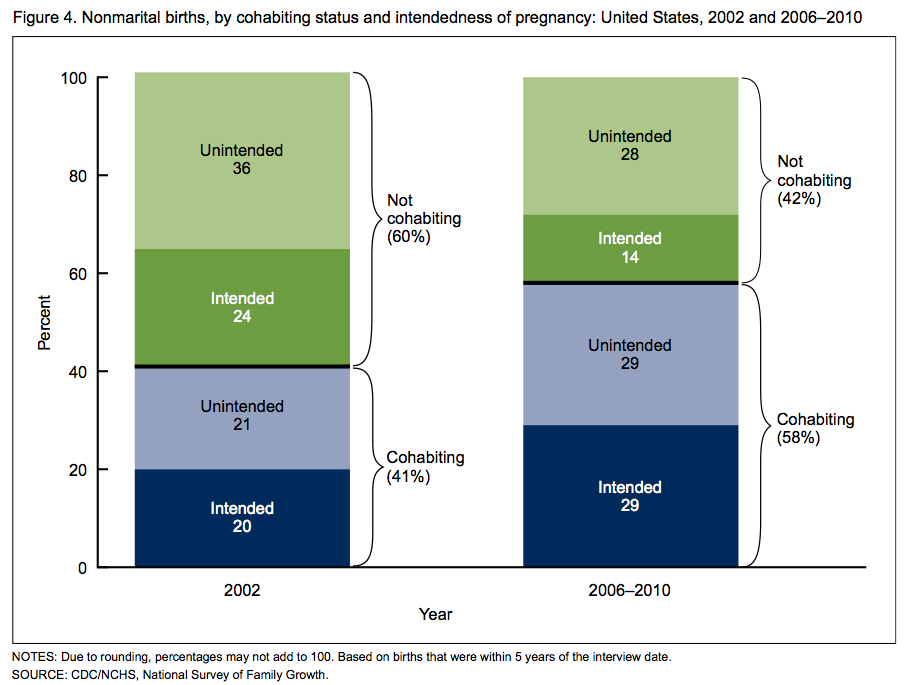
According to a new report just released by the National Health Center for Health Statistics, there has been a sharp decline in the number of kids born to single moms.
About 1.6 million women who weren’t married had kids in 2012, down from 1.75 million in 2007 and 2008. And more of those kids were born to co-habiting couples than before. Since not having two parents around is linked with an increased likelihood of having a lousy childhood and a more difficult life, that should be a cause for rejoicing.
This is the first significant decrease in several decades in what’s known as “nonmarital births.” (Probably “out-of-wedlock” sounded too Jacobean). But on closer inspection it’s not unalloyed good news.
Even after the recent sharp decrease, the number of kids born to single moms is still twice as high as it was in the 80s. And while the nonmarital birthrate has dropped 7% since the late 2000s, the overall birthrate—the number of births to all women—has dropped twice as much. What that means is that the percentage of kids born to single moms hasn’t changed much: 40% of all the people born in America have parents who aren’t married.
Similarly, while single black and Hispanic women are less likely to have a kid than they were in 2008 (the rate has dropped particularly sharply for Hispanic women), 72% of black kids and 54% of Hispanic kids are brought into the world via single moms. That number hasn’t budged much since 2011.
There are nuggets of good news in the report: the teen birth rate continues to fall. And the number of births to cohabiting couples (versus mothers who do not live with a partner) represents a much bigger slice of the unmarried birth pie than it did 10 years ago. In 2002, 60% of single women who gave birth were not living with the father. Now it’s down to 42%. But again, this number doesn’t look quite as good under close inspection.
Take this chart for example:

One indicator of a likelihood of a stable childhood is whether or not the child was planned. In the chart above, unintended pregnancies among women who are not living with a guy—the archetypal single mom—are down from 36% of the nonmarital births in 2002 to 28% by 2010. But unintended pregnancies among cohabiting couples went up. So the proportion of kids born to single moms who weren’t trying to have a kid did not change between 2002 and 2010: 57%. (And the raw number of nonmarital births is about 300,000 higher, so that’s a lot more unplanned kids).
How much difference does it make if the father and mother are living together when the kid is born? The jury is out on that. A lot depends on the circumstances under which people shack up. Studies have shown that if a couple is living together and intends to get married in a year or so, there’s very little difference in the stability of their union compared to married couples.
But couples who are living together out of economic necessity, or because they can’t quite decide if they can make the relationship work are less likely to stay together for a longer term. A child can really complicate that. It doesn’t seem yet that the U.S. is at that European-style place where kids born to couples who live together are in the same boat, stability-wise, as those with married parents.
Recent studies suggest cohabitation can make a slight difference, but so does a father’s age, education and race. (Absent black fathers are much more involved in their kids’ lives, than absent Hispanic fathers, and by some measures, than absent white fathers, according to this study.) “The extent to which cohabitation is a marker for social and financial support and for father involvement deserves further exploration,” write the authors of this new study.
One of the clearest findings of the Fragile Families Study done by Princeton University and the Brookings Institute in 2010, was that even if a baby was conceived by accident, many single fathers originally intended to stick around when the infant was born. But they didn’t. The combined pressures of poverty and parenthood proved to be too much for the relationship. The fact that the nonmarital birth rate has dropped is not at all the same as a drop in the number of kids born into very difficult family circumstances.
More Must-Reads from TIME
- Donald Trump Is TIME's 2024 Person of the Year
- Why We Chose Trump as Person of the Year
- Is Intermittent Fasting Good or Bad for You?
- The 100 Must-Read Books of 2024
- The 20 Best Christmas TV Episodes
- Column: If Optimism Feels Ridiculous Now, Try Hope
- The Future of Climate Action Is Trade Policy
- Merle Bombardieri Is Helping People Make the Baby Decision
Contact us at letters@time.com